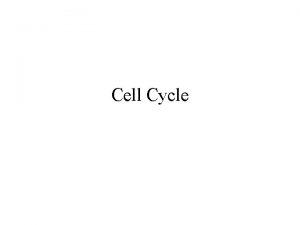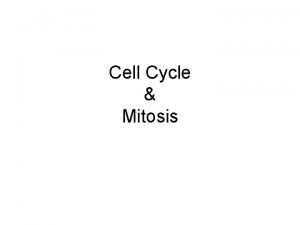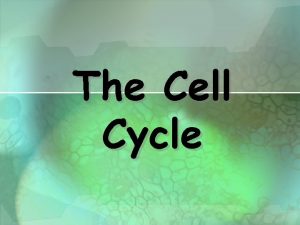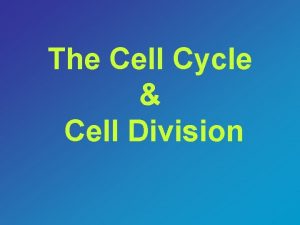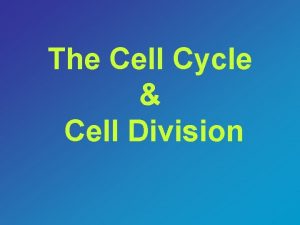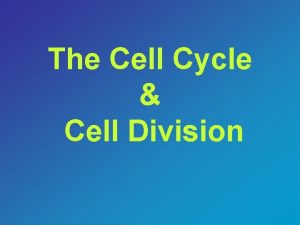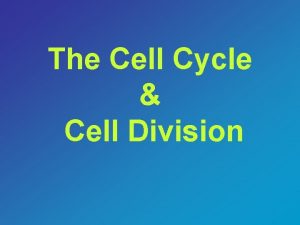The Cell Cycle Overview of the Cell Cycle














- Slides: 14

The Cell Cycle Overview of the Cell Cycle - Simplified Overview of the Cell Cycle - Detailed

Cells come from pre-existing cells Three things are required for a cell to be able to reproduce: 1. DNA Replication – “Copying the Instruction Manual” 2. Nuclear division – “Division of the Nucleus” (Mitosis) 3. Cell division – “Dividing the materials of the cell” (Cytokinesis)

DNA Replication

Packaging DNA for Nuclear Division (Mitosis) “The Package” – The Chromosome Key Components Sister chromatids Centromere

Nuclear Division - Mitosis Rap Mitosis Song Terms to know: Centrosome Chromatin Chromosome Sister Chromatid Spindle Microtubules Centromere Kinetochore Daughter Chromosomes


Metaphase Prometaphase Prophase Anaphase Telophase & Cytokinesis Go G 2 The Cell Cycle S G 1

interphase metaphase prophase anaphase prometaphase / late prophase telophase

A quick overview of cell division The genetic information of plants, animals and other eukaryotic organisms resides in several (or many) individual DNA molecules, or chromosomes. For example, each human cell possesses 46 chromosomes, while each cell of an onion possesses 8 chromosomes. All cells must replicate their DNA when dividing. During DNA replication, the two strands of the DNA double helix separate, and for each original strand a new complementary strand is produced, yielding two identical DNA molecules. DNA replication yields an identical pair of DNA molecules (called sister chromatids) attached at a region called the centromere. Sister Chromatids

Stages of Mitosis • Prophase. During prophase, the chromosomes supercoil and the fibers of the spindle apparatus begin to form between centrosomes located at the pole of the cells. The nuclear membrane also disintegrates at this time, freeing the chromosomes into the surrounding cytoplasm. • Prometaphase. During prometaphase, some of the fibers attach to the centromere of each pair of sister chromatids and they begin to move toward the center of the cell. • Metaphase. At metaphase the chromosomes have come to rest along the center plane of the cell. • Anaphase. During anaphase, the centromeres split and the sister chromatids begin to migrate toward the opposite poles of the cell. • Telophase. During telophase, the chromosomes at either end of the cell cluster begin to cluster together, which facilitates the formation of a new nuclear membrane. • This also is when cytokinesis occurs, leading to two separate cells. One way to identify that telophase has begun is by looking for the formation of the cell plate, the new cell wall forming between the two cells

Mitosis

Count the number of cells in each stage Stage Interphase Prometaphase Metaphase Ananphase Telophase Cytokinesis Percent time in each stage

Time for Mitosis Number of cells in each stage divided the total number of cell counted times 100 = percent time spent in each stage. Multiple the percent time 24. That will give you the number pie sections to fill in. 1/24 of the pie

Time for Mitosis q. Interphase q. Prometaphase q. Metaphase q. Anaphase q. Telophase q. Cytokinesis
 Cell signaling overview
Cell signaling overview Cell cycle and cell division
Cell cycle and cell division Cell cycle and cell division
Cell cycle and cell division Biology.arizona.edu/cell bio/activities/cell cycle/01.html
Biology.arizona.edu/cell bio/activities/cell cycle/01.html Cell cycle phases in order
Cell cycle phases in order Hát kết hợp bộ gõ cơ thể
Hát kết hợp bộ gõ cơ thể Lp html
Lp html Bổ thể
Bổ thể Tỉ lệ cơ thể trẻ em
Tỉ lệ cơ thể trẻ em Chó sói
Chó sói Tư thế worms-breton
Tư thế worms-breton Alleluia hat len nguoi oi
Alleluia hat len nguoi oi Môn thể thao bắt đầu bằng chữ đua
Môn thể thao bắt đầu bằng chữ đua Thế nào là hệ số cao nhất
Thế nào là hệ số cao nhất Các châu lục và đại dương trên thế giới
Các châu lục và đại dương trên thế giới















